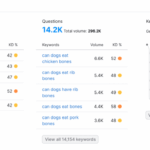5 possible reasons for your websites low conversion rate – 5 possible reasons for your website’s low conversion rate. This deep dive explores the crucial factors impacting your online success. From flawed website design to ineffective marketing strategies, we uncover five potential culprits hindering your visitors from becoming customers. Understanding these elements is key to boosting conversions and achieving your business goals.
We’ll examine website design and user experience, content quality and relevance, call-to-actions and conversion paths, marketing and promotion strategies, and technical issues and website performance. Each area will be explored in detail, offering actionable insights and strategies for improvement.
Website Design & User Experience

A website’s design and user experience (UX) are crucial for driving conversions. A well-designed site intuitively guides visitors through the desired actions, while a poorly designed one can lead to frustration and abandonment. This section explores key elements that impact UX and conversion rates, providing practical examples and actionable insights.Poor website design and user experience are often the root causes of low conversion rates.
Understanding the pitfalls and best practices in design is crucial for optimizing user journeys and increasing the likelihood of conversions.
Negative Design Elements Impacting User Experience
Poor design choices can significantly hinder user experience, leading to a decline in conversion rates. The following elements are frequently problematic:
- Cluttered layouts: Overwhelming users with excessive text, images, and design elements can create a chaotic and confusing experience. Users may struggle to find what they need, leading to frustration and abandonment. A cluttered layout can also make the site appear unprofessional and less trustworthy.
- Slow loading speeds: Users have very short attention spans. Slow-loading websites result in a negative user experience and a higher bounce rate. Users are more likely to abandon a site that takes too long to load, especially on mobile devices.
- Poorly designed forms: Complicated or confusing forms discourage users from completing the desired action. Clear, concise forms with intuitive fields are crucial. Excessive fields, obscure instructions, and errors in the form design can all deter users.
- Inadequate mobile responsiveness: With mobile devices becoming the primary access point for many users, websites need to be optimized for different screen sizes. Non-responsive designs result in a poor user experience on smaller screens, causing users to abandon the site. This negatively affects conversions as well.
- Lack of visual hierarchy: A website without a clear visual hierarchy makes it difficult for users to understand the structure and importance of different elements. This can lead to confusion and frustration, causing users to abandon the site.
Effective Website Layouts Guiding Users
Effective website layouts prioritize user needs and guide them through the desired actions. Consider the following examples:
- Clear Call-to-Actions (CTAs): Prominent and well-designed CTAs clearly indicate the desired action. A well-placed and attractive button can significantly increase conversions.
- Intuitive Navigation: Simple and easy-to-understand navigation makes it easy for users to find the information they need. Logical menus and clear labeling enhance the user experience and guide them through the desired action.
- Visually Appealing Design: Attractive design elements that are consistent with the brand identity can engage users and create a positive experience.
- Whitespace and Spacing: Effective use of whitespace and spacing helps to organize content and make it easier to read. This can create a clean and uncluttered aesthetic, improving the user experience.
- Progressive Disclosure: Showing only necessary information at each stage of the user journey can reduce cognitive load and keep users engaged.
Website Navigation and Site Architecture
Website navigation and architecture play a vital role in shaping the user journey.
- Logical Navigation Structure: A clear and logical navigation structure helps users find what they need quickly and easily. This can lead to improved user satisfaction and increased conversions.
- Intuitive Site Architecture: A well-organized site architecture helps users understand the site’s structure and find information efficiently. This is key to providing a positive user experience.
User Interface (UI) Design Flaws
Poor UI design can create frustration and prevent conversions. Common flaws include:
- Inconsistent Design Elements: Inconsistency in fonts, colors, and other design elements can disrupt the user experience and make the site appear unprofessional.
- Poor Typography Choices: Unreadable or poorly chosen fonts can make the site difficult to read and impact the overall user experience.
- Lack of Accessibility Features: Failing to adhere to accessibility guidelines can exclude users with disabilities, leading to a negative user experience and potentially losing conversions.
User Experience Testing Methods
User experience testing provides valuable insights into potential conversion rate issues.
| Testing Method | Potential Insights | Example Application | Cost & Resources |
|---|---|---|---|
| A/B Testing | Identify variations in design that yield higher conversion rates. | Comparing two versions of a landing page to see which performs better. | Moderate |
| Usability Testing | Understand how users interact with the site and identify pain points. | Observing users as they navigate the site and completing tasks. | Moderate to High |
| Eye-tracking Studies | Determine where users focus their attention on the page. | Analyzing eye movements to understand where users look and what elements they prioritize. | High |
| Surveys | Gather feedback on the user experience directly from users. | Collecting feedback on the site’s design and functionality. | Low |
| Heatmaps | Visualize user interaction with the website, highlighting areas of high and low engagement. | Visual representation of mouse movements and clicks on the website. | Moderate |
Content Quality & Relevance
High-quality content is crucial for driving conversions on your website. It establishes credibility, attracts and engages your target audience, and ultimately encourages them to take the desired action. Poor content, on the other hand, can significantly hinder your conversion rates by failing to resonate with users, failing to address their needs, and ultimately driving them away. This section delves into the specifics of creating content that effectively supports your conversion goals.Understanding your target audience’s needs and desires is paramount to crafting compelling content.
Content should directly address the user’s search intent, providing valuable information and solutions tailored to their specific queries and motivations. Incorporating relevant s and phrases, while maintaining a natural flow and tone, is essential for achieving optimal visibility and engagement.
Types of Low-Quality Content
Poor content quality can manifest in several ways, impacting user experience and ultimately conversion rates. Here are five types of low-quality content that can hurt your website conversions:
- Copied and Pasted Content: Plagiarized content, lacking originality and unique insights, does not offer value to users. This often leads to a negative user experience and damages your website’s credibility.
- Thin Content: Content that is too short, superficial, or lacks sufficient detail fails to provide comprehensive answers or solutions. Users may perceive it as unhelpful and move on to more thorough resources.
- Irrelevant Content: Content that doesn’t align with user needs or search intent is a waste of effort. Users will likely abandon the page without finding the information they are seeking.
- Outdated Content: Information that is no longer current or accurate is not useful. This can damage your website’s credibility and cause users to distrust your brand.
- Poorly Written Content: Grammatical errors, typos, and unclear language create a poor user experience and damage your credibility. Poorly written content can make it difficult for users to understand the message.
Improving Content Quality
To enhance your content quality, focus on creating original, comprehensive, and relevant content. Ensure your content addresses the user’s search intent and provides valuable insights and solutions. Thorough research, editing, and proofreading are essential for producing high-quality content that builds trust and credibility.
Figuring out why your website isn’t converting visitors into customers can be tricky. Five potential reasons could be poor website design, unclear calls to action, or a lack of trust signals. But, it’s also crucial to consider Google’s updated raters guidelines, which refine the concept of low quality googles updated raters guidelines refines concept of low quality.
These guidelines highlight how a poor user experience, reflected in slow loading times or confusing navigation, can hurt your conversion rates. Ultimately, addressing these issues is key to boosting your website’s performance.
Optimizing Content for User Search Intent
To optimize content for user search intent, understand the questions users are asking and the information they are seeking. Conduct thorough research to identify relevant terms and phrases. Analyze user behavior on your website to understand what content resonates most. Use this information to tailor your content to align with user needs and desires.
Content Gaps and How to Fill Them
Identifying and filling content gaps can significantly improve your website’s conversion rates. Here are five common content gaps:
- Lack of Product/Service Descriptions: In-depth descriptions of products or services help users understand their value proposition. Adding high-quality images and videos can also improve engagement.
- Missing FAQ Pages: Frequently asked questions pages address user queries directly, reducing friction and improving understanding.
- Inadequate Case Studies: Real-world examples of how your products or services solve problems are invaluable. Showcasing success stories builds trust and credibility.
- Insufficient Customer Testimonials: User reviews and testimonials provide social proof and build trust. Incorporating customer feedback directly into your website enhances credibility.
- Missing Visual Content: Visual elements like images, videos, and infographics can significantly improve user engagement and comprehension. These elements enhance the user experience and break up large blocks of text.
Content Formats for Conversions
Different content formats can be used to engage users and drive conversions. Blog posts, articles, and videos each have their strengths. The most effective format will depend on your target audience and the specific message you want to convey.
Strategies for Creating Resonant Content
| Strategy | Target Audience Understanding | Content Relevance | Engagement Tactics |
|---|---|---|---|
| Research | Identify key terms and phrases relevant to user needs | Align content with user search intent | Incorporate s naturally |
| User Persona Development | Create detailed profiles of ideal customers | Tailor content to specific user needs | Use user-centric language |
| Competitor Analysis | Identify gaps and opportunities in the market | Highlight unique selling propositions | Offer unique value |
| Data-Driven Optimization | Track user behavior and engagement | Identify areas for improvement | Iterate and refine content |
| Content Repurposing | Maximize the reach of existing content | Adapt content for different formats | Maintain consistent brand messaging |
Call-to-Actions (CTAs) & Conversion Paths
Understanding your website’s call-to-actions (CTAs) and conversion paths is crucial for driving sales and achieving business objectives. A poorly designed CTA or a cumbersome conversion process can significantly hinder your website’s performance, leading to missed opportunities. Optimizing these elements is a key strategy for improving conversion rates and maximizing the value of your website traffic.Effective CTAs and conversion paths are essential to guide users towards desired actions, ensuring a seamless and engaging experience.
A well-structured conversion process, coupled with compelling CTAs, is vital to increase user engagement and ultimately drive conversions.
Ineffective CTA Button Designs
Poorly designed CTAs can be a significant obstacle to conversions. These designs often fail to capture attention, communicate value effectively, or encourage users to take the desired action.
- Small, Unnoticeable Buttons: Buttons that are too small or lack visual prominence are easily overlooked by users. This can lead to users missing the opportunity to complete a desired action.
- Generic or Vague Text: Buttons with vague or generic text like “Click Here” or “Submit” fail to communicate the specific benefit or action the user will take. This can result in users being unsure of the outcome and hesitant to proceed.
- Inconsistent Button Styles: Using different button styles or colors throughout the website can confuse users and make the call to action less prominent. This disrupts the user experience and makes it harder for them to locate and interact with the buttons.
- Poorly Placed Buttons: Buttons that are placed awkwardly or in areas where they are not easily visible can lead to a lack of engagement. This results in a negative user experience and potentially missed opportunities.
- Lack of Urgency/Scarcity: Buttons without a sense of urgency or limited-time offers can fail to motivate users to act quickly. This leads to a delay in decision-making, potentially resulting in a loss of interest and conversions.
Compelling CTA Button Designs
Effective CTAs are designed to capture attention, communicate value, and encourage desired actions. These designs use clear language, prominent placement, and compelling visuals to drive conversions.
Figuring out why your website isn’t converting as expected can be tricky. There are 5 key reasons, from unclear calls to action to a clunky checkout process. But did you know that Google recently updated product markup to support member pricing sales? This update might be a factor, potentially improving search visibility and attracting more qualified leads, impacting conversion rates indirectly.
So, while this is a helpful improvement, it’s still crucial to analyze the fundamental elements of your website’s design and user experience to truly understand your conversion rate.
- Large, Prominent Buttons: Large, visually appealing buttons that stand out from the surrounding content increase visibility and encourage interaction. This ensures users are able to easily identify the desired call-to-action.
- Clear and Actionable Text: Use specific and concise language that clearly communicates the benefit of the action, such as “Shop Now,” “Get a Free Quote,” or “Learn More.” This clarity helps users understand the desired outcome and motivates them to proceed.
- Consistent Button Styles: Maintaining a consistent style for buttons throughout the website provides a clear and unified user experience. This promotes ease of navigation and understanding of the intended actions.
- Strategically Placed Buttons: Placement is key; CTAs should be strategically placed to maximize visibility and ensure users see them naturally while navigating the website. This ensures that the CTA is easily accessible and in line with the user’s current task.
- Sense of Urgency/Scarcity: Adding a sense of urgency or scarcity can encourage users to act quickly. For example, using phrases like “Limited-time offer” or displaying a countdown timer can motivate users to complete the desired action.
Conversion Path Obstacles
Conversion paths can be hindered by various obstacles, leading to a decrease in conversions. Understanding and removing these obstacles can significantly improve your website’s performance.
Figuring out why your website isn’t converting visitors into paying customers can be tricky. Perhaps you need to improve your calls to action or streamline the checkout process. One key area to consider, especially if you’re selling group memberships, is ensuring a smooth membership purchase experience. Learning how to sell group memberships in WordPress for corporate teams, for example, can significantly impact conversion rates.
Check out this guide on how to sell group memberships in WordPress for corporate teams for some actionable strategies. Ultimately, understanding your website’s user journey and addressing any friction points is crucial for boosting those conversion rates.
- Complex Navigation: A complex or confusing navigation system can disorient users and make it difficult for them to find the desired products or information. This leads to frustration and a high bounce rate.
- Insufficient Information: A lack of necessary information, such as product descriptions or customer testimonials, can leave users unsure of the value proposition and cause them to abandon the process.
- Technical Issues: Technical glitches or slow loading times can significantly hinder the user experience and lead to lost conversions.
- Unclear Checkout Process: A lengthy or confusing checkout process can deter users and lead to abandoned carts.
- Lack of Trust Signals: A lack of trust signals, such as security badges or customer testimonials, can make users hesitant to proceed with a purchase. This creates doubts in their minds and prevents them from completing the purchase.
CTA Placement Strategies, 5 possible reasons for your websites low conversion rate
Different CTA placement strategies can impact conversion rates. Careful consideration of where CTAs are placed is essential for optimizing the user experience and driving conversions.
| Placement Strategy | Effect on Conversion Rates | Example | Additional Considerations |
|---|---|---|---|
| Top of Page | High visibility, potential for immediate action. | A prominent “Shop Now” button at the top of an e-commerce website. | Ensure it doesn’t disrupt the user’s initial engagement. |
| Within Content | Contextual relevance, increased engagement. | A “Learn More” button within a blog post. | Match the button’s purpose to the surrounding content. |
| After Content Consumption | Follow-up action, reinforcement of value proposition. | A “Download the eBook” button after a lead magnet landing page. | Ensure the call to action is logically linked to the previous content. |
| Throughout Navigation | Accessibility, consistent reinforcement. | “Add to Cart” buttons on product pages. | Consistency in placement across the site is key. |
Optimizing the Checkout Process
A seamless and user-friendly checkout process is essential for converting visitors into customers. A streamlined process significantly increases the chances of completing a purchase.
- Clear and Concise Steps: The checkout process should be broken down into clear, concise steps, minimizing the cognitive load on the user.
- Secure Payment Options: Offering a variety of secure payment options builds trust and encourages users to proceed with the purchase.
- Progress Indicators: Providing progress indicators during the checkout process helps users track their progress and stay engaged.
- Easy Cart Management: Allowing users to easily manage their cart, including removing items or updating quantities, minimizes potential errors and friction.
- Order Confirmation: Providing clear and concise order confirmation emails and tracking information builds trust and ensures a smooth post-purchase experience.
Marketing & Promotion Strategies
A website’s low conversion rate can often stem from ineffective marketing and promotion strategies. Simply launching a website and hoping for traffic isn’t enough. A well-defined and executed marketing plan is crucial for driving desired actions from visitors. This section dives into common pitfalls and provides actionable strategies to boost conversion rates.Effective marketing isn’t just about reaching a large audience; it’s about reaching the right audience with the right message at the right time.
A well-structured marketing strategy, tailored to the target audience and website’s unique value proposition, is essential for achieving a high return on investment (ROI).
Ineffective Marketing Strategies
Many businesses fall into the trap of employing marketing strategies that fail to generate conversions. These strategies may bring traffic, but they often fail to convert visitors into customers. Common ineffective strategies include:
- Focusing on broad, unfocused advertising campaigns targeting a wide audience instead of a specific demographic.
- Employing marketing strategies without tracking their effectiveness, making it hard to identify what’s working and what’s not.
- Using generic, non-engaging content across all marketing channels, failing to tailor the message to the platform.
- Ignoring the importance of building relationships with potential customers through personalized interactions and consistent communication.
- Failing to integrate marketing efforts with other parts of the business, creating a disconnect and hindering a holistic approach.
Effective Marketing Strategies for Driving Conversions
Implementing effective marketing strategies is crucial for driving conversions. These strategies are tailored to generate leads and boost sales.
- Targeted Advertising Campaigns: Instead of casting a wide net, focus on specific demographics and interests. This ensures that your marketing efforts reach the most relevant potential customers. This targeted approach often leads to a higher conversion rate, as the audience is more likely to be interested in your product or service. For example, a clothing store targeting young adults in urban areas would likely see higher conversion rates than one targeting a broader audience.
- Data-Driven Marketing: Monitor the performance of your marketing campaigns in real-time. Track key metrics like website traffic, click-through rates, and conversion rates. Analyzing this data helps you understand what’s working and what’s not, allowing for adjustments and optimizations. Tools like Google Analytics provide invaluable insights for this process.
- Engaging Content Marketing: Create valuable, informative content that resonates with your target audience. This content should educate, entertain, and address their needs. This can take the form of blog posts, articles, videos, infographics, or other formats tailored to the specific platform. Content marketing builds trust and authority, ultimately driving conversions.
- Relationship-Building Strategies: Foster connections with potential customers through personalized interactions and consistent communication. This could include email marketing campaigns, social media engagement, and customer support. Building relationships creates a sense of community and trust, leading to higher conversion rates.
- Integrated Marketing Approach: Align all marketing efforts with the overall business goals. Ensure that your website, social media, email marketing, and other channels are working together to achieve a cohesive and unified message. This creates a consistent brand experience for the customer, increasing trust and driving conversions.
Measuring Marketing Channel Success
Tracking the effectiveness of marketing channels is essential to optimize campaigns and maximize conversions.
- Conversion Rate Tracking: Monitor the percentage of visitors who complete a desired action (e.g., making a purchase, signing up for a newsletter). This metric directly indicates the effectiveness of your marketing strategies in driving desired outcomes.
- Cost Per Acquisition (CPA): Calculate the cost of acquiring a new customer through each marketing channel. This metric helps evaluate the ROI of different campaigns.
- Return on Ad Spend (ROAS): Measure the revenue generated for every dollar spent on advertising. This metric helps assess the profitability of your marketing efforts.
- Website Traffic Analysis: Examine where your website traffic is coming from. Identify which marketing channels are driving the most valuable traffic and focus efforts on those channels.
- Customer Journey Mapping: Analyze the steps a customer takes from initial interaction to conversion. This mapping helps identify bottlenecks and areas for improvement.
Crucial Aspects of a Successful Marketing Strategy
A successful marketing strategy encompasses several key aspects.
- Clear Target Audience Definition: Understand your ideal customer profile and tailor your messaging to their specific needs and preferences. This focused approach ensures that your marketing efforts reach the right people.
- Well-Defined Goals: Establish specific, measurable, achievable, relevant, and time-bound (SMART) goals. This helps track progress and measure the success of your marketing initiatives.
- Compelling Value Proposition: Clearly articulate the benefits and value of your product or service. Highlight how it solves a problem or satisfies a need for your target audience.
- Consistent Brand Messaging: Maintain a consistent brand image and message across all marketing channels. This creates a cohesive brand experience and builds trust with potential customers.
- Continuous Optimization: Regularly evaluate and adjust your marketing strategies based on data and feedback. This iterative process ensures that your campaigns remain effective and aligned with your goals.
Advertising Platform Comparison
The effectiveness of advertising platforms varies based on the target audience and campaign objectives.
| Advertising Platform | Strengths | Weaknesses | Effectiveness in Driving Conversions |
|---|---|---|---|
| Social Media | Highly targeted advertising options, potential for viral campaigns, diverse audience reach | High competition, algorithm changes can impact visibility | Moderate to high, depending on the platform and campaign targeting |
| Search Engines (e.g., Google Ads) | High visibility for relevant searches, strong targeting options | Can be expensive, requires ongoing optimization | High, particularly for product-based searches |
| Email Marketing | Direct communication with potential customers, high ROI potential | Requires a high-quality email list, susceptible to spam filters | High, if email list is managed effectively |
| Paid Influencer Marketing | Credibility and trust from influential figures | Potential for misalignment with brand values, difficult to measure ROI | Moderate to high, depending on influencer relevance and campaign execution |
Technical Issues & Website Performance
A website’s technical performance is a critical factor in achieving high conversion rates. A slow, unreliable, or insecure site can significantly deter potential customers, leading to lost opportunities and decreased revenue. Understanding and addressing these technical aspects is crucial for optimizing the user experience and maximizing conversion potential.Technical glitches, slow loading times, and security concerns are significant hurdles to a positive user experience.
Addressing these issues directly impacts user trust and encourages visitors to complete desired actions. Websites with consistent performance and security measures build confidence and encourage engagement, ultimately leading to higher conversion rates.
Common Technical Website Issues
Numerous technical issues can hinder a website’s effectiveness. These range from simple loading problems to more complex security vulnerabilities. Recognizing these potential pitfalls is the first step toward improvement.
- Slow loading times, affecting user engagement and ultimately conversion rates.
- Inconsistent website performance across different devices (desktop, mobile, tablets).
- Technical glitches or errors that interrupt the user experience, causing frustration and abandonment.
- Security vulnerabilities, compromising user data and damaging trust in the website.
- Poorly optimized code, resulting in sluggish performance and a negative user experience.
Website Loading Speed Optimization
Website loading speed is a critical factor influencing user experience and conversion rates. Fast loading times translate to higher user satisfaction and encourage visitors to stay longer on the site, exploring its content and potentially converting.
- Optimize Images: Compressing images without compromising quality is essential. Use formats like WebP or AVIF, which often provide better compression than JPEG or PNG, resulting in faster loading times. Employ responsive image techniques that adjust image dimensions based on the user’s device.
- Minimize HTTP Requests: Fewer requests translate to faster loading times. Combine multiple CSS and JavaScript files into fewer files, use CSS sprites, and leverage browser caching to reduce the number of requests the browser needs to make.
- Choose a Reliable Hosting Provider: A fast and reliable hosting provider is paramount. Consider factors like server location, server response time, and uptime. The provider’s infrastructure significantly impacts website performance.
- Leverage Browser Caching: Browser caching allows the browser to store static assets (images, CSS, JavaScript) locally. This reduces loading times on subsequent visits by retrieving assets directly from the cache.
- Optimize Code and Scripts: Minimize unnecessary code and scripts. Use efficient JavaScript frameworks and libraries, and ensure code is well-structured for optimal performance. Use tools to identify and eliminate unused or redundant code.
Website Security Vulnerabilities and Errors
Website security is paramount for building user trust. Vulnerabilities and errors can erode trust, leading to a decrease in conversions. Implementing robust security measures is essential for maintaining user confidence and protecting sensitive data.
- Regular Security Audits: Regular security audits are essential for identifying potential vulnerabilities and addressing them promptly. These audits should cover all aspects of the website, including server-side code, databases, and user input validation.
- Implementing Secure Practices: Implementing security best practices is critical. This includes using strong passwords, regularly updating software, and employing secure coding practices.
- Protecting User Data: Protecting user data is paramount. Employing encryption methods like HTTPS is essential for safeguarding sensitive information during transmission.
- Addressing Error Messages: Clearly displaying error messages in a user-friendly manner, and providing solutions or redirects, can help mitigate frustration.
- Monitoring Website Security: Monitoring the website’s security posture continuously is essential for proactively identifying and resolving potential issues. Utilizing security monitoring tools can detect unusual activity or vulnerabilities.
Troubleshooting Website Performance Problems
Identifying and resolving performance problems requires a systematic approach. Tools and techniques can be used to pinpoint bottlenecks and implement solutions.
- Utilize Performance Monitoring Tools: Monitoring tools provide insights into website performance metrics. This helps pinpoint areas of concern, such as slow loading times or high resource consumption.
- Analyze Server Logs: Analyzing server logs provides detailed information about website activity. This helps identify errors, unusual behavior, or potential performance bottlenecks.
- Identify Bottlenecks: Identify bottlenecks in the website’s performance. This involves analyzing various components, including server response time, database queries, and network latency.
- Implement Performance Improvements: Implement solutions to resolve identified performance issues. This may involve optimizing code, upgrading server hardware, or improving network connectivity.
- Testing and Validation: Test and validate implemented solutions to ensure they resolve the identified performance problems. Continuously monitor performance after implementing changes to ensure sustained improvement.
Website Performance Testing Tools
Performance testing tools help in evaluating website performance under various conditions. This enables identification of bottlenecks and areas for optimization.
| Tool | Capabilities | Pros | Cons |
|---|---|---|---|
| Google PageSpeed Insights | Analyzes page speed and provides recommendations for optimization. | Free, easy to use, comprehensive analysis. | Limited in-depth performance testing. |
| GTmetrix | Provides similar analysis to PageSpeed Insights, offering detailed reports and recommendations. | Free tier available, comprehensive reports. | Can be complex to interpret. |
| WebPageTest | Allows for testing of website performance under different network conditions and locations. | Wide range of testing options, flexible configurations. | Can be complex to set up. |
| LoadView | Simulates real user traffic to evaluate website performance under load. | Detailed load testing capabilities. | Can be expensive. |
| JMeter | Open-source tool that allows for advanced load testing scenarios. | Open-source, customizable. | Steeper learning curve. |
End of Discussion: 5 Possible Reasons For Your Websites Low Conversion Rate

In conclusion, optimizing your website for conversions requires a multifaceted approach. By meticulously analyzing these five crucial elements, you can identify specific areas needing attention and implement targeted improvements. Remember, a well-designed website, compelling content, clear calls-to-action, effective marketing, and a smooth user experience are all vital for driving conversions and achieving business success. The journey to higher conversion rates begins with understanding these key factors, and implementing actionable steps.






